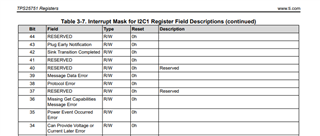Other Parts Discussed in Thread: TPS25750, , BQ25731
Dear TI support,
we are currently trying to continue the development of our smart power bank with replaceable 4s battery after switching from TPS25750 to TPS25751.
We are facing some problems, could you please point us in right direction?
1) We noticed that patch download doesn't work on 400000kHz I2C timing, we had to lower the CLK frequency to 200000kHz to make it work. On higher CLK (400000kHz) we never passed step 11 (Read DATA1 = 0 Successfully completed - we read always 64) in patch download flowchart. Is this known issue?
2) We configure the TPS25751 in the way attached TPS25751_config.json shows. The device operate correctly in Sink mode, connected to Source power supply it establishes PD contract and powers up our battery charging block (we use BQ25731 charging IC).
3) When we disconnect from external power source (Source) and connect ST development Sink device, it establish PD contract at 5V / 3000mA and so far works fine. The problem is, when we try to switch to higher voltage contract (9V / 3000mA), we enable OTG mode on BQ25731 to output 9V, then we select on ST development board to establish contract wit PDO2 (9V / 3000mA) but this never passes and ends up always with HARD RESET (see attached picture from PD analyzer).

4) Which GPIO signal can be used for BQ25731 OTG mode enable? Is it enablesource_port1 (73)? This signal goes high right after 5V / 3000mA PD contract is established and stays high
5) We need to be checking the state of TPS25751 in order to display correct information (sink info - battery charging and battery state or source info - output current etc) on embedded OLED screen, so we tried to observe the state of TPS25751_REG_RX_TYPEC_STATE register and especially its 31-24 bit field - TypeC Port State. This bits seems to show correct 0x60 - Attached.SRC or 0x61 - Attached.SNK state, but sometimes, occasionally it show 0x01 state, which is not described anywhere and this is causing us troubles in how to detect TPS25751 state from host MCU. Any thoughts, please?
thank you




